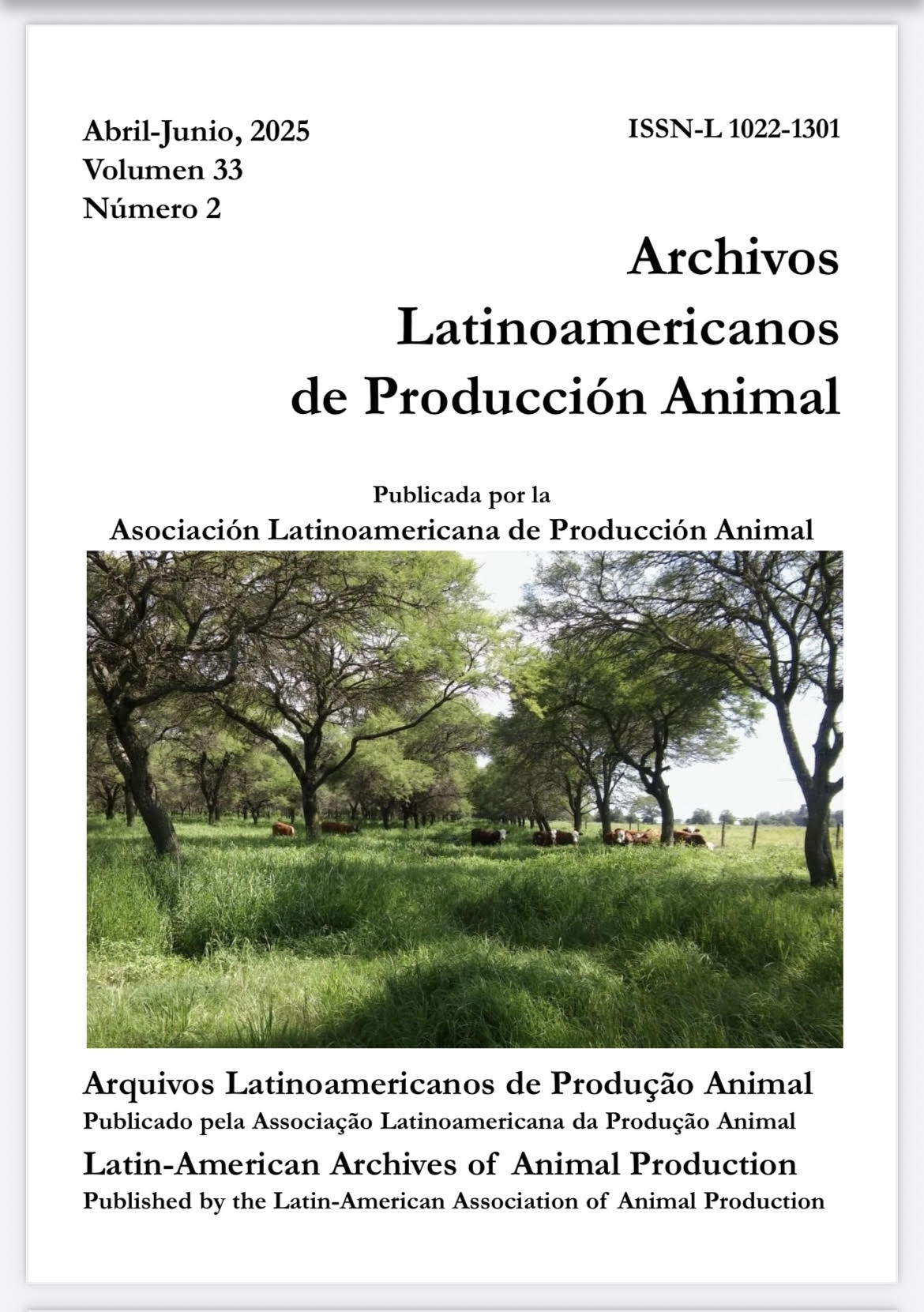Early University Training in Animal Production with ChatGPT: Effect of Student Profile
Abstract
he pedagogical use of ChatGPT was evaluated in an introductory animal production course (2nd year, Veterinary Sciences, UNICEN, Argentina). Volunteer students (104, 94% of the course) individually addressed a specific productive, environmental, and/or economic problem facilitated by the instructors in the form of an initial "Prompt." Participants had to generate and justify three additional prompts following a before-after logic. Subsequently, they had to complete two surveys (Google Forms®) and submit a report with ChatGPT's responses within a 30-day deadline. The first survey included six classification variables and seven Likert scale (1-5) response variables, followed by a second survey with three additional questions.. Descriptive, cluster, and ANOVA analyses were conducted. The experience was positively evaluated, with an average satisfaction score of 4.2 out of 5 regarding ChatGPT’s responses. However, 74% of students expressed doubts about the reliability of the information, although only 16% verified it with other sources. AI was perceived as more useful in professional practice (3.8 out of 5) than in academic training (3.3 out of 5). The study confirms ChatGPT’s versatility and its acceptance as an educational tool in animal production. Two main components were identified, explaining 54.7% of the variance in students' interaction with AI: those with prior experience in artificial intelligence perceived greater usefulness and quality in the responses (CP1), while those with less experience in animal production or oriented towards small animal health encountered more difficulties (CP2). Although this study is preliminary and has a limited scope, its findings are promising and provide a foundation for future complementary evaluations. The educational challenge remains to promote an AI usage approach that strengthens autonomous critical thinking.
Downloads
References
Almazrou, S., Alanezi, F., Almutairi, S.A., AboAlsamh, H.M., Alsedrah, I.T., Arif, W.M., Alsadhan, A.A., AlSanad, D.S., Alqahtani, N.S., AlShammary, M.H., Bakhshwain, A.M., Almuhanna, A.F., Almulhem, M., Alnaim, N., Albelali, S., Attar, R.W., 2024. Enhancing medical students critical thinking skills through ChatGPT: An empirical study with medical students. Nutr. Health 02601060241273627. https://doi.org/10.1177/02601060241273627
Alonso Sousa, S., Flay, K.J., 2024. A Survey of Veterinary Student Perceptions on Integrating ChatGPT in Veterinary Education Through AI-Driven Exercises. J. Vet. Med. Educ. e20240075. https://doi.org/10.3138/jvme-2024-0075
Bainbridge, L., 1983. Ironies of automation. Automatica 19, 775–779. https://doi.org/https://doi.org/10.1016/0005-1098(83)90046-8
Baumhover, A., Hansen, S.L., 2024. Preparing the AI-assisted animal scientist: faculty and student perspectives on enhancing animal science education with artificial intelligence. Anim. Front. 14, 54–56. https://doi.org/10.1093/af/vfae038
Bećirović, S., Mattoš, B., 2024. Artificial Intelligence in the Transformation of Higher Education: Threats, Promises and Implementation Strategies, in: Digital Transformation in Higher Education, Part A: Best Practices and Challenges. Emerald Publishing Limited, pp. 23–43.
Chu, C.P., 2024. ChatGPT in veterinary medicine: a practical guidance of generative artificial intelligence in clinics, education, and research. Front. Vet. Sci. 11, 1395934. https://doi.org/10.3389/fvets.2024.1395934
Chyung, S.Y. (Yonnie), Roberts, K., Swanson, I., Hankinson, A., 2017. Evidence-Based Survey Design: The Use of a Midpoint on the Likert Scale. Perform. Improv. 56, 15–23. https://doi.org/https://doi.org/10.1002/pfi.21727
Coleman, M.C., Moore, J.N., 2024. Two artificial intelligence models underperform on examinations in a veterinary curriculum. J. Am. Vet. Med. Assoc. 262, 692–697. https://doi.org/10.2460/javma.23.12.0666
Danylenko, G., 2024. AI in veterinary medicine: The next paradigm shift. [WWW Document]. URL https://digitail.com/blog/artificial-intelligence-in-veterinary-medicine-thenext-paradigm-shift/ (accessed 10.1.24).
Di Rienzo, J.A., Casanoves, F., Balzarini, M.G., Gonzalez, L., Tablada, M., Robledo, C.W., 2019. InfoStat Centro de Transferencia InfoStat, FCA, Universidad Nacional de Córdoba, Argentina. URL http://www.infostat.com.ar
Firaina, R., Sulisworo, D., 2023. Exploring the Usage of ChatGPT in Higher Education: Frequency and Impact on Productivity. Bul. Edukasi Indones. https://doi.org/10.56741/bei.v2i01.310
Goldberg, C.B., Adams, L., Blumenthal, D., Brennan, P.F., Brown, N., Butte, A.J., Cheatham, M., DeBronkart, D., Dixon, J., Drazen, J., 2024. To do no harm—and the most good—with AI in health care. Nejm Ai. 1:3 https://doi.org/10.1056/AIp2400036
Iglesias, J.L., Nadin, L., Williams, K., Pinto de Almeida, A., Tejedo, M.E., Machado, C.F., 2020. Caracterización de estudiantes de veterinaria en una etapa temprana de su carrera. Docencia Vet. 4, 30–36.
Kilag, O. K., Miñoza, J., Comighud, E., Amontos, C., Damos, M., & Abendan, C. F. 2023. Empowering teachers: Integrating technology into livelihood education for a digital future. Excellencia: International Multi-disciplinary Journal of Education (2994-9521), 1(1), 30-41.
Kirschner, P.A., Sweller, J., Clark, R.E., 2006. Why Minimal Guidance During Instruction Does Not Work: An Analysis of the Failure of Constructuvist, Discovery, Problem-Based, Experimental, and Inquiry-Based Teaching. Educ. Psychol. 42, 75–86. https://doi.org/10.1207/s15326985ep4102_1
Lee, H.-P.H., Sarkar, A., Tankelevitch, L., Drosos, I., Rintel, S., Banks, R., Wilson, N., 2025. The Impact of Generative AI on Critical Thinking: Self-Reported Reductions in Cognitive Effort and Confidence Effects From a Survey of Knowledge Workers. https://doi.org/10.1145/3706598.3713778
Luckin, R., Holmes, W., 2016. Intelligence unleashed: An argument for AI in education. Open Ideas; Pearson Education, London. 60p.
Machado, C.F., Arroqui, M., Mangudo, P., Alvarez, J.R., Mateos, C., Zunino, A., 2020. Exploración de innovaciones en sistemas de producción de carne con modelos de simulación: experiencia interdisciplinaria y oportunidades de aplicación en el paradigma de internet de las cosas. Electron. J. SADIO 19, 43–63. https://sedici.unlp.edu.ar/handle/10915/135044
Machado, C.F., Williams, K., Nadin, L.B., Iglesias, J.L., Tejedo, M.E., Schang, E., Dogna, B., Castelletti, A., 2023. Diversidad de perfiles y desafíos para el desarrollo profesional veterinario: motivación temprana de estudiantes con testimonios de graduados. Docencia Vet. 41–46. https://shorturl.at/rUxPD
Mayberry, D., Hatcher, S., Cowley, F., 2020. New skills, networks and challenges: the changing face of animal production science in Australia. Anim. Prod. Sci. 61, 201–207. https://doi.org/10.1071/AN20115
McDavid, L., San Miguel, S.F., 2024. Using a Positive Psychology Lens to Understand How Veterinary Medicine Learning Contexts Promote Student Thriving and Inhibit Frustration. J. Vet. Med. Educ. e20240024. https://doi.org/10.3138/jvme-2024-0024
Melisa, R., Ashadi, A., Triastuti, A., Hidayati, S., Salido, A., Ero, P.E.L., Marlini, C., Zefrin, Z., Al Fuad, Z., 2025. Critical Thinking in the Age of AI: A Systematic Review of AI’s Effects on Higher Education. Educ. Process Int. J. https://doi.org/10.22521/edupij.2025.14.31
Navea-Martín, A., Suárez-Riveiro, J.M., 2017. Estudio sobre la utilización de estrategias de automotivación en estudiantes universitarios. Psicol. Educ. - Educ. Psychol. 23, 115–121. https://doi.org/10.1016/j.pse.2016.08.001
Nazari, M., Saadi, G., 2024. Developing effective prompts to improve communication with ChatGPT: a formula for higher education stakeholders. Discov. Educ. 3, 45. https://doi.org/10.1007/s44217-024-00122-w
Ragland, E.C., Radcliffe, S., Karcher, E.L., 2023. A review of the application of active learning pedagogies in undergraduate animal science curricula. J. Anim. Sci. 101, skac352. https://doi.org/10.1093/jas/skac352
Rodríguez Alvarez, J., Arroqui, M., Mangudo, P., Toloza, J., Jatip, D., Rodriguez, M.J., Teyseyre, A., Sanz, C., Zunino, A., Machado, C., Mateos, C., 2019. Estimating Body Condition Score in Dairy Cows From Depth Images Using Convolutional Neural Networks, Transfer Learning and Model Ensembling Techniques. Agronomy 9, 90. https://doi.org/10.3390/agronomy9020090
Roll, I., Wylie, R., 2016. Evolution and revolution in artificial intelligence in education. Int. J. Artif. Intell. Educ. 26, 582–599. https://doi.org/10.1007/s40593-016-0110-3
Ross, E.M., 2023. Embracing artificial intelligence in the classroom. Harvard Graduate School of Education.
Šlapeta, J., 2023. Are ChatGPT and other pretrained language models good parasitologists? Trends Parasitol. 39, 314–316. https://doi.org/10.1016/j.pt.2023.02.006
Sok, S., Heng, K., 2024. Opportunities, challenges, and strategies for using ChatGPT in higher education: A literature review. J. Digit. Educ. Technol. 4, ep2401. https://doi.org/10.30935/jdet/14027
Trevino, N.N., DeFreitas, S.C., 2014. The relationship between intrinsic motivation and academic achievement for first generation Latino college students. Soc. Psychol. Educ. 17, 293–306. https://doi.org/10.1007/s11218-013-9245-3
Tullo, E., Finzi, A., Guarino, M., 2019. Review: Environmental impact of livestock farming and Precision Livestock Farming as a mitigation strategy. Sci. Total Environ. 650, 2751–2760. https://doi.org/https://doi.org/10.1016/j.scitotenv.2018.10.018
Urban, M., Děchtěrenko, F., Lukavský, J., Hrabalová, V., Svacha, F., Brom, C., Urban, K., 2024. ChatGPT improves creative problem-solving performance in university students: An experimental study. Comput. Educ. 215, 105031. https://doi.org/10.1016/j.compedu.2024.105031
Ward Jr, J.H., 1963. Hierarchical grouping to optimize an objective function. J. Am. Stat. Assoc. 58, 236–244. https://doi.org/10.2307/2282967
Worthing, K.A., Roberts, M., Šlapeta, J., 2024. Surveyed veterinary students in Australia find ChatGPT practical and relevant while expressing no concern about artificial intelligence replacing veterinarians. Vet. Rec. Open 11, e280. https://doi.org/https://doi.org/10.1002/vro2.80
Zhang, Y., Huang, J., Huang, H., Li, X., Jin, Y., Guo, H., Feng, Q., Zhao, Y., 2022. Grassland aboveground biomass estimation through assimilating remote sensing data into a grass simulation model. Remote Sens. 14, 3194. https://doi.org/10.3390/rs14133194
Copyright (c) 2025 Claudio F. Machado, Jose Luis Iglesias, Maria Emilia Tejedo, Karen Williams, Laura B. Nadin, Marcelo Rodriguez

This work is licensed under a Creative Commons Attribution-NonCommercial-ShareAlike 4.0 International License.





